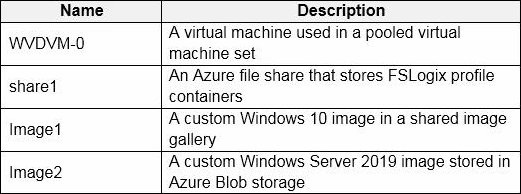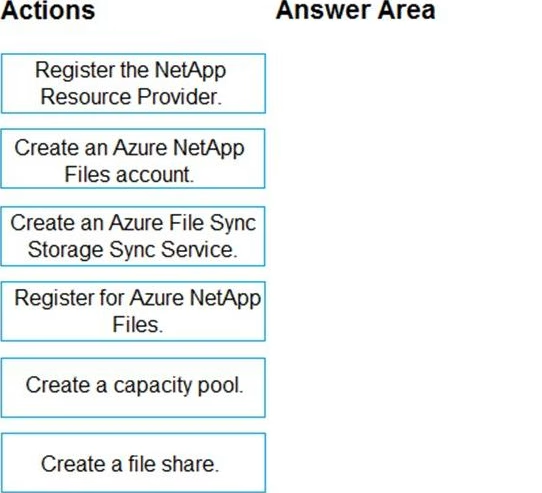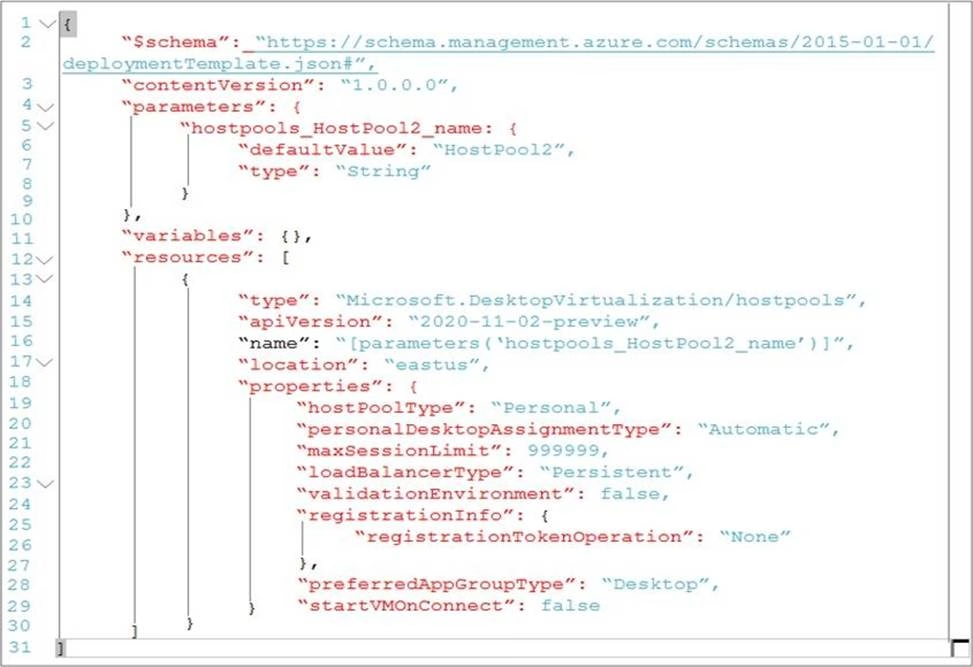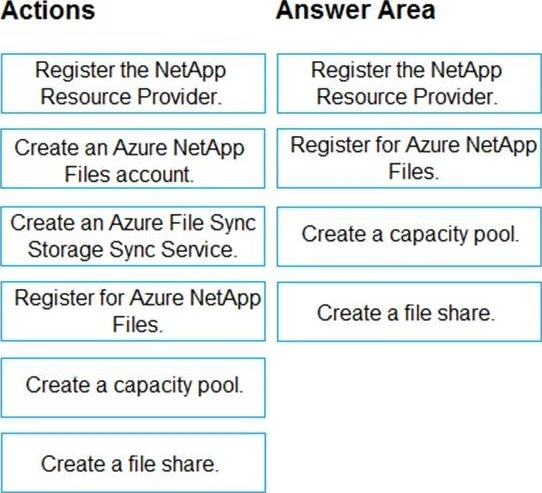Microsoft AZ-140 Configuring and Operating Microsoft Azure Virtual Desktop Online Training
Microsoft AZ-140 Online Training
The questions for AZ-140 were last updated at Feb 21,2025.
- Exam Code: AZ-140
- Exam Name: Configuring and Operating Microsoft Azure Virtual Desktop
- Certification Provider: Microsoft
- Latest update: Feb 21,2025
You have an Azure subscription that contains the resources shown in the following table.

Which resources can you back up by using Azure Backup?
- A . WVDVM-0 and share1 only
- B . WVDVM-0 only
- C . WVDVM-0, Image1, and Image2 only
- D . WVDVM-0, share1, and Image1 only
- E . WVDVM-0, share1, Image1, and Image2
DRAG DROP
You have a Windows Virtual Desktop host pool named Pool1. Pool1 contains session hosts that use FSLogix profile containers hosted in Azure NetApp Files volumes.
You need to back up profile files by using snapshots.
Which three actions should you perform in sequence? To answer, move the appropriate actions from the list of actions to the answer area and arrange them in the correct order.

You are designing an Azure Virtual Desktop deployment.
You identify the network latency between the locations where users reside and the planned deployment.
What should you use to identify the best Azure region to deploy the host pool?
- A . Azure Traffic Manager
- B . Azure Virtual Desktop Experience Estimator
- C . Azure Monitor for Azure Virtual Desktop
- D . Azure Advisor
You have an Azure Virtual Desktop host pool named Pool1 in the East US region.
You have a storage account named storage1 that contains FSLogix profile containers. In the East US region, you have a shared image gallery named SIG1 that contains a virtual machine image named Image1. Image1 is used to create new session hosts in Pool1.
You plan to deploy a new Azure Virtual Desktop host pool named Pool2 to the South India region.
You need to implement a session host deployment solution for Pool2 that meets the following requirements:
✑ Image1 must replicate in the South India region.
✑ The session hosts in Pool2 must be based on Image1.
✑ Changes to Image1 must be available in the South India and East US regions.
What should you include in the solution?
- A . Create a new shared image gallery named SIG2 in the South India region. Upload a copy of Image1 to SIG2.
- B . Create a new Azure Storage account named storage2 in the South India region. Copy Image1 to a shared folder in storage2.
- C . From SIG1, update the replication for the latest image version of Image1.
- D . Configure geo-redundant storage (GRS) replication for storage1. Copy the VHD file of Image1 to the FSLogix profile container.
You have an Azure Virtual Desktop host pool. The pool contains session hosts that run Windows 10 Enterprise multi-session.
You connect to a Remote Desktop session on Pool1 and discover an issue with the frequency of screen updates.
You need to identify whether the issue relates to insufficient server, network, or client resources. The solution must minimize how long it takes to identify the resource type.
What should you do?
- A . From within the current session, use the Azure Virtual Desktop Experience Estimator.
- B . From Azure Cloud Shell, run the Get-AzOperationalInsightsWorkspaceUsage cmdlet and specify the DefaultProfile parameter.
- C . From Azure Cloud Shell, run the Get-AzWvdUserSession cmdlet and specify the UserSessionId parameter.
- D . From within the current session, use Performance Monitor to display the values of all the RemoteFX Graphics(*)Frames Skipped/Second counters.
DRAG DROP
You have an Azure Virtual Desktop host pool named Pool1.
You need to ensure that you can create an Azure NetApp Files volume that will host user profiles for Pool1.
Which four actions should you perform in sequence? To answer, move the appropriate actions from the list of actions to the answer area and arrange them in the correct order. NOTE: More than one order of answer choices is correct. You will receive credit for any of the correct orders you select.

You have an Azure Active Directory (Azure AD) tenant named contoso.com.
You use a user account named Admin1 to deploy an Azure Active Directory Domain Services (Azure AD DS) managed domain named aaddscontoso.com to a virtual network named VNET1.
You plan to deploy an Azure Virtual Desktop host pool named Pool1 to VNET1.
You need to ensure that you can use the Admin1 user account to deploy Windows 10 Enterprise session hosts to Pool1.
What should you do first?
- A . Add Admin1 to the AA Change Host pool type to Pooled and specify Load D DC Administrators group ofcontoso.com.
- B . Assign the Cloud device administrator role to Admin1.
- C . Assign a Microsoft 365 Enterprise E3 license to Admin1.
- D . Change the password of Admin1.
You have an Azure Virtual Desktop host pool named Pool1 that contains the following:
✑ A linked workspace named Workspace1
✑ An application group named Default Desktop
✑ A session host named Host1
You need to add a new data disk.
What should you modify?
- A . Host1
- B . Workspace 1
- C . Pool1
- D . Default Desktop
HOTSPOT
You are automating the deployment of an Azure Virtual Desktop host pool.
You deploy the Azure Resource Manager (ARM) template shown in the following exhibit.

Use the drop-down menus to select the answer choice that completes each statement based on the information presented in the Dockerfile. NOTE: Each correct selection is worth one point.

You have an Azure Virtual Desktop deployment.
You have a RemoteApp named App1.
You discover that from the Save As dialog box of App1, users can run executable applications other than App1 on the session hosts.
You need to ensure that the users can run only published applications on the session hosts.
What should you do?
- A . Configure a conditional access policy in Azure Active Directory (Azure AD).
- B . Modify the Access control (1AM) settings of the host pool.
- C . Modify the RDP Properties of the host pool.
- D . Configure an AppLocker policy on the session hosts.
Latest AZ-140 Dumps Valid Version with 53 Q&As
Latest And Valid Q&A | Instant Download | Once Fail, Full Refund




